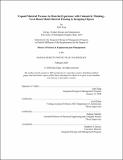| dc.contributor.advisor | Axel Kilian and Stefanie Mueller. | en_US |
| dc.contributor.author | Zeng, Jiani. | en_US |
| dc.contributor.other | Massachusetts Institute of Technology. Engineering and Management Program. | en_US |
| dc.contributor.other | System Design and Management Program. | en_US |
| dc.date.accessioned | 2021-02-19T20:15:13Z | |
| dc.date.available | 2021-02-19T20:15:13Z | |
| dc.date.copyright | 2020 | en_US |
| dc.date.issued | 2020 | en_US |
| dc.identifier.uri | https://hdl.handle.net/1721.1/129844 | |
| dc.description | Thesis: S.M. in Engineering and Management, Massachusetts Institute of Technology, System Design and Management Program, February, 2020 | en_US |
| dc.description | Cataloged from student-submitted version of thesis. | en_US |
| dc.description | Includes bibliographical references (pages 68-70). | en_US |
| dc.description.abstract | Material serves as the first touchpoint between an object and a person. In current product development, material together with color and finishing is regarded as a separate entity from the form and function design. Every material needs to be paired with a series of optimal manufacturing processes for the desired effect. In many cases, this is handled with material design specialists. People perceive a material primarily by its surface: chromatic, tactile, and decorative identity it displays or the temperature and hardness when touching it. Typically, this material surface can be viewed as a two-dimensional entity that reveals limited-expression and information to be delivered via human intervention. In this thesis, we propose to get away from surface obsession in object and industrial design, by adding another dimension to the material interface. By embedding information into three-dimensional matter, we introduce volumetric material: a new material organization that responds directly to the user intervention or the environment. With multi-material 3D printing, we envision a future in product development where the design of surface detail, texture, reflexivity can finally be merged with the overall product composition from the beginning of the design process. With voxel printing capability, we designed and tested material interface with depth and explored volumetric behavior that is both visually and functionally meaningful to the user, and discussed the results. | en_US |
| dc.description.statementofresponsibility | by Jiani Zeng. | en_US |
| dc.format.extent | 87 pages | en_US |
| dc.language.iso | eng | en_US |
| dc.publisher | Massachusetts Institute of Technology | en_US |
| dc.rights | MIT theses may be protected by copyright. Please reuse MIT thesis content according to the MIT Libraries Permissions Policy, which is available through the URL provided. | en_US |
| dc.rights.uri | http://dspace.mit.edu/handle/1721.1/7582 | en_US |
| dc.subject | Engineering and Management Program. | en_US |
| dc.subject | System Design and Management Program. | en_US |
| dc.title | Expand material presence to material experience with volumetric thinking : voxel based multi-material printing in designing objects | en_US |
| dc.title.alternative | Voxel based multi-material printing in designing objects | en_US |
| dc.type | Thesis | en_US |
| dc.description.degree | S.M. in Engineering and Management | en_US |
| dc.contributor.department | Massachusetts Institute of Technology. Engineering and Management Program | en_US |
| dc.identifier.oclc | 1237599155 | en_US |
| dc.description.collection | S.M.inEngineeringandManagement Massachusetts Institute of Technology, System Design and Management Program | en_US |
| dspace.imported | 2021-02-19T20:14:43Z | en_US |
| mit.thesis.degree | Master | en_US |
| mit.thesis.department | SysDes | en_US |
